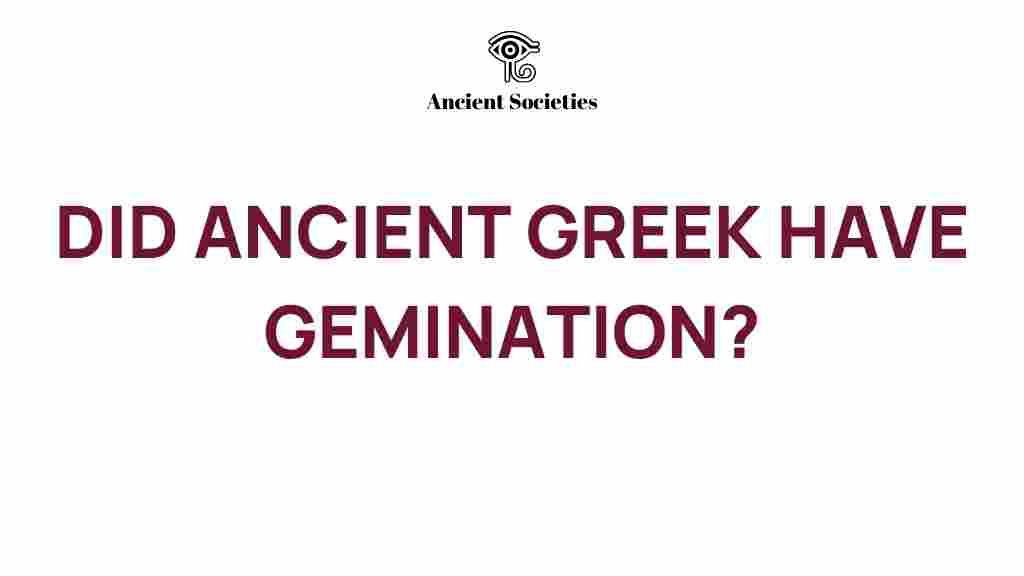Unveiling the Mystery: Did Ancient Greek Employ Gemination?
The study of Ancient Greek provides a fascinating glimpse into the evolution of language, phonetics, and the intricate details of its various dialects. One aspect that has intrigued linguists is the concept of gemination, which refers to the lengthening of consonants or vowels in a language. In this article, we will explore the possibility of gemination in Ancient Greek, examining its implications in linguistics, phonetics, and the broader context of Greek culture.
Understanding Gemination
Gemination occurs when a consonant or vowel is pronounced for an extended duration. This phenomenon can significantly affect the meaning of words and is a critical feature in many languages. For example, in Italian, the word “pala” (shovel) contrasts with “palla” (ball) solely based on the length of the consonant.
- Vowel Length: This pertains to the duration for which a vowel sound is held.
- Consonant Length: This involves the prolonged articulation of a consonant sound.
In Ancient Greek, vowel length is a well-documented feature, but the question remains: did the language also incorporate gemination as a phonetic characteristic?
The Role of Vowel and Consonant Length in Ancient Greek
To understand gemination in the context of Ancient Greek, it’s essential to examine how the language utilized vowel and consonant length. Ancient Greek employed a system where vowels could be categorized as short or long, influencing both pronunciation and meaning.
Vowel Length
Vowel length was a vital aspect of Ancient Greek phonetics. The distinction between short and long vowels was not just a phonetic feature but also critical in grammatical contexts, such as:
- Inflection: Different forms of a word could change meaning based on vowel length.
- Meter: Poetic structures depended heavily on the length of vowels.
Consonant Length
While vowel length is well documented, the concept of consonant length in Ancient Greek is a bit more controversial. Some scholars argue that certain consonants could be geminated, which would affect the pronunciation and meaning of words.
- Examples: Words like “ἄλλος” (allos – another) might contrast with a hypothetical “ἀλλος” (allos – similar) if gemination were applied.
- Differentiation: In some dialects, especially in the transition to Hellenistic Greek, the pronunciation and length of consonants may have shifted.
Evidence from Linguistic Studies
The question of gemination in Ancient Greek has been a topic of debate among linguists. Various studies have attempted to provide evidence for or against the existence of this phonetic characteristic.
Dialectal Variations
Ancient Greek was not a monolithic language; it consisted of various dialects, such as Attic, Ionic, Doric, and Aeolic. Each dialect exhibited unique phonetic features, which may have influenced the presence or absence of gemination.
- Attic Greek: This dialect is known for its clarity and structure, often avoiding gemination.
- Doric Greek: Some scholars suggest that Doric might have had instances of consonant lengthening.
Phonetic Evidence
Phonetic studies involving the reconstruction of Ancient Greek pronunciation have provided insights into potential gemination. Some analyses of ancient texts and inscriptions suggest that certain consonants were indeed pronounced with more emphasis, indicating a form of gemination.
Gemination in Other Languages: A Comparative Approach
Understanding gemination in the context of Ancient Greek can also be aided by examining how other languages implement this phonetic feature. Languages such as Arabic, Japanese, and Finnish utilize gemination effectively, which provides a framework for analyzing Ancient Greek.
- Arabic: Features both consonant and vowel gemination, significantly affecting meaning.
- Japanese: Utilizes both long vowels and geminated consonants, essential in distinguishing words.
Step-by-Step Process of Analyzing Gemination in Ancient Greek
To analyze the presence of gemination in Ancient Greek, linguists often follow a systematic approach:
- Textual Analysis: Investigating ancient texts for phonetic markers that may indicate gemination.
- Comparative Linguistics: Comparing findings with other languages that exhibit gemination.
- Dialect Studies: Examining how different dialects of Ancient Greek might have approached consonant and vowel length.
- Phonetic Reconstruction: Utilizing phonetic models to understand potential pronunciations in Ancient Greek.
Troubleshooting Common Misconceptions
While engaging with the concept of gemination in Ancient Greek, several misconceptions can arise:
- Misunderstanding Vowel Length: Some may confuse the length of vowels with gemination; however, they are distinct features.
- Assuming Uniformity: Not all Ancient Greek dialects employed gemination the same way; regional differences are crucial.
Conclusion: The Lingering Questions
In conclusion, the question of whether Ancient Greek employed gemination remains partially unresolved. While substantial evidence supports the existence of vowel length, the status of consonant length and gemination is still debated among linguists. As we delve deeper into the rich history of Greek culture and its language, the exploration of phonetic features like gemination can shed light on the intricacies of Ancient Greek dialects.
For further reading on the topic of gemination and its implications in various languages, you can visit the Linguistic Society of America. To explore more about Ancient Greek and its fascinating linguistic features, check out this comprehensive guide.
This article is in the category History and created by AncientSocieties Team
